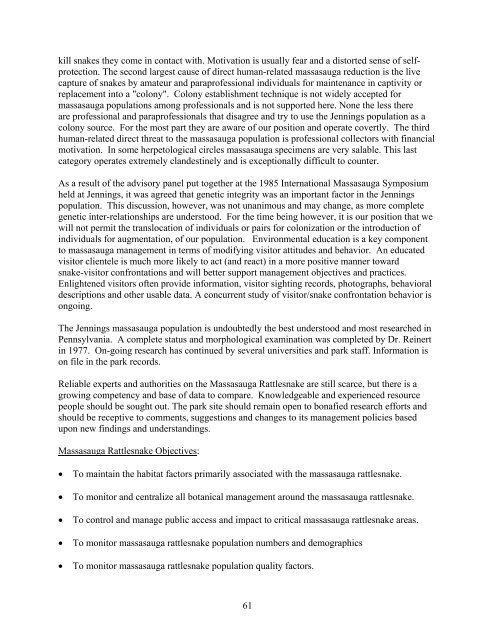The Eastern Massasauga Rattlesnake: - U.S. Fish and Wildlife Service
The Eastern Massasauga Rattlesnake: - U.S. Fish and Wildlife Service
The Eastern Massasauga Rattlesnake: - U.S. Fish and Wildlife Service
Create successful ePaper yourself
Turn your PDF publications into a flip-book with our unique Google optimized e-Paper software.
kill snakes they come in contact with. Motivation is usually fear <strong>and</strong> a distorted sense of self-<br />
protection. <strong>The</strong> second largest cause of direct human-related massasauga reduction is the live<br />
capture of snakes by amateur <strong>and</strong> paraprofessional individuals for maintenance in captivity or<br />
replacement into a "colony". Colony establishment technique is not widely accepted for<br />
massasauga populations among professionals <strong>and</strong> is not supported here. None the less there<br />
are professional <strong>and</strong> paraprofessionals that disagree <strong>and</strong> try to use the Jennings population as a<br />
colony source. For the most part they are aware of our position <strong>and</strong> operate covertly. <strong>The</strong> third<br />
human-related direct threat to the massasauga population is professional collectors with financial<br />
motivation. In some herpetological circles massasauga specimens are very salable. This last<br />
category operates extremely cl<strong>and</strong>estinely <strong>and</strong> is exceptionally difficult to counter.<br />
As a result of the advisory panel put together at the 1985 International <strong>Massasauga</strong> Symposium<br />
held at Jennings, it was agreed that genetic integrity was an important factor in the Jennings<br />
population. This discussion, however, was not unanimous <strong>and</strong> may change, as more complete<br />
genetic inter-relationships are understood. For the time being however, it is our position that we<br />
will not permit the translocation of individuals or pairs for colonization or the introduction of<br />
individuals for augmentation, of our population. Environmental education is a key component<br />
to massasauga management in terms of modifying visitor attitudes <strong>and</strong> behavior. An educated<br />
visitor clientele is much more likely to act (<strong>and</strong> react) in a more positive manner toward<br />
snake-visitor confrontations <strong>and</strong> will better support management objectives <strong>and</strong> practices.<br />
Enlightened visitors often provide information, visitor sighting records, photographs, behavioral<br />
descriptions <strong>and</strong> other usable data. A concurrent study of visitor/snake confrontation behavior is<br />
ongoing.<br />
<strong>The</strong> Jennings massasauga population is undoubtedly the best understood <strong>and</strong> most researched in<br />
Pennsylvania. A complete status <strong>and</strong> morphological examination was completed by Dr. Reinert<br />
in 1977. On-going research has continued by several universities <strong>and</strong> park staff. Information is<br />
on file in the park records.<br />
Reliable experts <strong>and</strong> authorities on the <strong>Massasauga</strong> <strong>Rattlesnake</strong> are still scarce, but there is a<br />
growing competency <strong>and</strong> base of data to compare. Knowledgeable <strong>and</strong> experienced resource<br />
people should be sought out. <strong>The</strong> park site should remain open to bonafied research efforts <strong>and</strong><br />
should be receptive to comments, suggestions <strong>and</strong> changes to its management policies based<br />
upon new findings <strong>and</strong> underst<strong>and</strong>ings.<br />
<strong>Massasauga</strong> <strong>Rattlesnake</strong> Objectives:<br />
• To maintain the habitat factors primarily associated with the massasauga rattlesnake.<br />
• To monitor <strong>and</strong> centralize all botanical management around the massasauga rattlesnake.<br />
• To control <strong>and</strong> manage public access <strong>and</strong> impact to critical massasauga rattlesnake areas.<br />
• To monitor massasauga rattlesnake population numbers <strong>and</strong> demographics<br />
• To monitor massasauga rattlesnake population quality factors.<br />
61

















